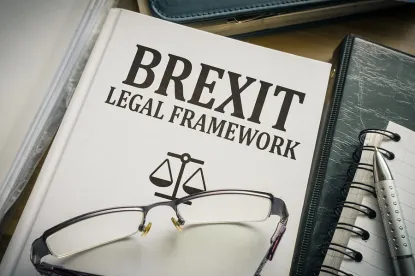It is now less than two months until 29 March 2019, the date set for the UK’s withdrawal from the EU. At this late stage, the terms of the UK’s withdrawal have still not been settled, and the Brexit issue remains clouded in uncertainty.
As a result of a vote in the UK Parliament 29 January, the UK will now seek to renegotiate one of the terms of the withdrawal agreement agreed in draft with the EU at the end of 2018. This term is the “Irish backstop”, the dual purpose of which is to preserve an open border between Ireland and Northern Ireland post-Brexit and to guarantee the integrity of the EU’s post-Brexit borders. The EU’s initial reaction to the vote has been to indicate that it sees no reason to renegotiate. Without amendment to this term, however, the UK’s withdrawal agreement as a whole is very unlikely to receive the parliamentary approval required for it to become binding on the EU and UK.
The key points to note in light of these developments are as follows:
-
A no-deal Brexit on 29 March is still possible: There is still a significant likelihood that the UK will exit the EU without any agreed withdrawal terms on 29 March 2019, the date fixed in UK and EU law as the exit date. Although Parliament on 29 January expressed opposition to this scenario, it has not voted to block it. A “no-deal” or “cliff edge” Brexit will mean that there is no soft landing in the form of a transitional period to allow the EU and UK to adjust to their new relationship. There will simply be an abrupt end to the UK’s membership of the EU at 23:00GMT (00:00CET) on 29 March.
-
An extension to the 29 March Brexit date is also still possible: If the EU concedes its current position and agrees to negotiate, there is a significant likelihood that the Brexit date will need to be extended. Although the prime minister has ruled this out, for the time being, saying she intends to complete renegotiations with the EU by 13 February, this is a very ambitious timetable and does not provide for the possibility that the EU may decide to renegotiate other withdrawal terms. A further complication is that any extension will require unanimous consent of the UK and the other 27 EU member states and amendment of the UK’s EU Withdrawal Act.
-
Businesses should prepare for a no-deal Brexit: Continuing uncertainty over the circumstances of Brexit at this late stage means that businesses should prepare for a no-deal Brexit.
-
The withdrawal agreement is not the final EU/UK agreement: The permanent EU/UK relationship will be the subject of a separate trading agreement which has not yet been negotiated – under EU law, this is possible only after Brexit. The withdrawal agreement, if finalised, will provide only for the terms of the UK’s exit from the EU and what will happen before the permanent agreement is concluded. Clearly, finalisation of this agreement is likely to make negotiation of a permanent agreement easier.
What is the Irish Backstop, and How Could It Change?
The “Irish backstop” is the basis for Parliament’s vote to reopen the draft withdrawal agreement. It has a dual purpose. First, it respects the Good Friday peace agreement for the island of Ireland by ensuring that an open border is maintained between the Republic of Ireland (which will remain in the EU) and Northern Ireland (which, as part of the UK, will leave the EU) after Brexit. Second, it protects the integrity of the EU single market. That it has become a stumbling block to the withdrawal agreement is puzzling to some, given that legal provisions already exist to control relationships between individual EU member states and non-EU states where they have common borders, and that there are non-physical measures in place already for monitoring movements across the Ireland/Northern Ireland border to cater for differences in matters such as VAT rates.
The EU’s proposal during negotiations leading up to the draft withdrawal agreement had been that the EU/UK border should be between the island of Great Britain and Northern Ireland, meaning that Northern Ireland would stay a member of the EU customs union, bound by a number of EU single-market rules and the EU VAT system pending the final EU/UK trade agreement to be negotiated after Brexit. The UK government rejected this arrangement, stating it would disrupt the integrity of the UK, and proposed that the whole of the UK would remain in the EU customs union until the final trade agreement with the EU was reached, with Northern Ireland continuing to comply with a number of single market rules. The EU accepted this on the basis that the arrangement would continue until both the EU and the UK agreed it was no longer required. Although this provision was intended as a last-resort arrangement, Parliament effectively achieved a reversal of the UK’s position by rejecting it on 15 January on the grounds that the UK would not have the ability to withdraw from the arrangement unilaterally and that, as the arrangement had no fixed end date, the UK could be committed to permanent membership of the customs union.
The 29 January vote saw Parliament approve a proposal to abandon this Irish backstop and conclude binding “alternative arrangements” with the EU. Although there is no clear information on what these alternative arrangements might be, the prime minister indicated she would look to negotiate a right for the UK to withdraw unilaterally, or a fixed time for the new arrangement, or an open border accompanied by a technological solution – all previously rejected by the EU. In reaction, the EU stated that the withdrawal terms, negotiated intensively over more than 18 months, were not open for renegotiation and warned that the UK faced an increased risk of a no-deal Brexit. However, the EU’s assertion does not rule out a side agreement or amendment to the EU/UK political declaration outlining principles for their post-Brexit relationship.
What is the Brexit Date, and Could It Be Extended?
Brexit date is 29 March 2019, 23:00 UK time, midnight Brussels time. This date is fixed under Article 50 of the EU Treaty, which provides for an EU member state’s withdrawal from the EU within two years from the date of its withdrawal notice to the EU. It is also fixed by the UK’s EU Withdrawal Act. Any change to this date would therefore require the consent of the other 27 EU member states and an amendment to the Withdrawal Act.
On 29 January, Parliament also voted to reject a delay to the Brexit date, and the prime minister expressed confidence that a renegotiated deal could be achieved before 13 February. However, this is a short timetable for renegotiation of an issue that required over 18 months of discussion before the Irish backstop was agreed. And if the EU agrees to renegotiate, it may well seek to reopen other aspects of the draft terms, which could require further time – there are particular concerns that fisheries and Gibraltar could be put back on the agenda.
If the 13 February deadline is not met, the prime minister also confirmed there will be a further vote in Parliament on 14 February. At that point, MPs could vote in favour of seeking to extend the Brexit date to allow further time for negotiations, although this would leave little time for obtaining the other 27 EU member states’ consent and UK statutory amendment. Whilst the EU has stated it is willing to consider any UK request for extension, the UK would have to provide credible reasons for this in order to gain consent. Consequently, an extension is not guaranteed.
Any extension to the Brexit date would, of course, postpone the start of EU/UK negotiations towards a permanent EU/UK trade agreement – under Article 50, these cannot start in detail until after the UK has left the EU. The withdrawal agreement will provide only for the terms of the UK’s exit from the EU and during the period before the permanent agreement is concluded.
What Is a No-Deal Brexit, and Could It Happen?
29 January’s parliamentary session also saw a vote in favour of avoiding a no-deal Brexit. However, this vote is not binding on the government, and given the fluidity of the situation, a no-deal Brexit cannot be ruled out.
It remains possible that withdrawal terms in some form may be agreed before Brexit date, and that this date may be extended, but time is pressing. If renegotiations happen and are successful, the new terms will provide much-needed business certainty. They are also likely to preserve the original term providing for a transitional period until 31 December 2020, allowing time for the UK and the other 27 EU member states and their citizens and businesses to adjust to Brexit. The transitional period accounts for a significant part of the EUR 39 billion the UK would be committed to pay the EU if the withdrawal agreement were to be finalised. This financial obligation might soften the EU’s current refusal to countenance reopening the draft withdrawal agreement, as long as the UK’s position on the alternative to the Irish backstop is not overly onerous.
With a no-deal Brexit, on the other hand, the UK would leave the EU on 29 March without any agreement with the other 27 member states on several fundamental issues, and without transitional arrangements to ease the adjustment from UK membership of the EU to treatment of the UK as a third state.
That said, the EU and UK are proceeding with measures to protect citizens and businesses if this cliff-edge scenario materialises. However, these measures only provide for situations in which government intervention is necessary. The EU measures concern citizens’ rights, social security, financial services, transport, customs and export rules, and climate policy. The UK measures include additional resources to cater for any civil contingencies, funding for customs facilities, trade and security; and the national health services have been stockpiling medicines. Both sets of measures reflect an expectation that businesses will make their own arrangements to manage the impact of Brexit on their operations.
What Will Happen Next?
What will happen next is not yet clear. Despite the EU’s resistance, it is likely that the prime minister will return to Brussels to ask to renegotiate the Irish backstop. Whether or not the EU agrees to this, the same or an amended withdrawal agreement is likely to be proposed for a vote in Parliament on 14 February.
Beyond this, next steps are even less clear. If Parliament again rejects the agreement, options would include a no-deal Brexit, a direction to the government to negotiate a different agreement, a change in prime minister, a second referendum, or a general election. All but a no-deal Brexit would require postponement of the 29 March Brexit date, which could be achieved only with EU consent. UK withdrawal of its Brexit notice could be one outcome of a second referendum or general election, although the UK would have to demonstrate good faith.
Any option other than finalisation of the withdrawal agreement is likely to postpone negotiation of the important permanent-trading arrangements between the EU and UK, and in at least some cases may well make negotiation more difficult.
Preparation for a No-Deal Brexit Remains Prudent
Preparation for a no-deal Brexit remains a prudent risk-management policy, and many businesses are now stepping up the pace of their preparations to mitigate its effects. UK businesses will be impacted in different ways by a no-deal Brexit, but those with complex supply chains and import-export relations with the EU will likely face the worst impact.






 />i
/>i

